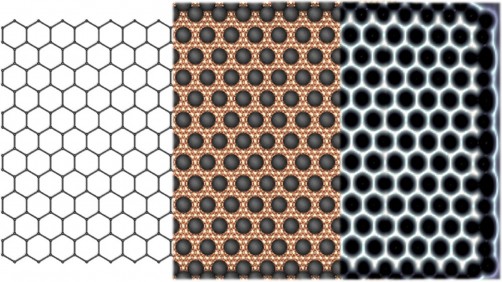| Nov 28, 2022 |
Scientists construct novel quantum testbed one atom at a time
(Nanowerk News) With atomic precision, scientists built a testbed to manipulate electrons in entirely new ways with potential applications in quantum computing.
|
|
Electrons are tiny objects that can carry electricity and information across materials and between devices. They are often visualized as discrete spheres, either moving through a circuit or connected to an atom. While this classical model works well for many scenarios, quantum mechanics paints a radically different picture of the nature of electrons involving waves, clouds and a lot of math.
|
|
As scientists gain more understanding of quantum mechanics, they are looking beyond our current methods to engineer materials with unique electronic properties that allow them to store and manipulate information in entirely new ways.
|
|
Scientists at the U.S. Department of Energy’s (DOE) Argonne National Laboratory have created a novel testbed to explore the behavior of electrons in a special class of materials called topological insulators, which could see applications in quantum computing (ACS Nano, "Artificial Graphene Nanoribbons: A Test Bed for Topology and Low-Dimensional Dirac Physics").
|
 |
| Left, atomic structure of actual graphene nanoribbon. Middle, CO molecules mapped onto a copper surface to produce graphene structure. Right, scanning tunneling microscope image of the resulting artificial graphene nanoribbon. (Image: Argonne National Laborator)
|
|
Topology — a field of mathematics regarding the nature of shapes — provides unique insight into the physics of materials. Electrons on the surface of topological insulators can exist in states that allow them to flow with almost no resistance. These states can also protect the system from external noise, or influence, a major challenge for emerging quantum information technologies.
|
|
Scientists are exploring the power of quantum mechanical phenomena like these topological states to store and communicate information with greater speed, security and energy efficiency.
|
|
“We were able to control the appearance of topological states in our testbed,” said Argonne theoretical physicist Pierre Darancet, a lead author on the paper. “Our work represents a step toward exploiting topological phenomena for quantum computing.”
|
I can’t believe it’s not graphene!
|
|
Super strong and a superior conductor of electrons, the material graphene is a one-atom-thick sheet of carbon atoms with many possible applications. In previous work, graphene nanoribbons — small strips of graphene — were shown to exhibit promising topological states. Inspired by this, the Argonne team constructed an artificial graphene testbed with atomic precision in hopes to further explore those topological effects.
|
|
“Making artificial graphene nanoribbons gave us more precise control over the system compared to synthesizing actual nanoribbons, which can be messy,” said Darancet. “It was a theorist’s dream to have experimentalists building atomic Legos atom by atom, and it allowed for greater manipulation and exploration of the topology.”
|
|
The team constructed artificial graphene nanoribbons by placing individual carbon monoxide (CO) molecules very precisely onto a copper surface using a scanning tunneling microscope (STM) at Argonne’s Center for Nanoscale Materials, a DOE Office of Science user facility.
|
|
Scientists generally use microscopes to gather information about materials. In this study, they used the STM to both create and investigate the material. They also developed computer algorithms to automate construction, allowing them to operate the STM remotely. “I would wake up, have my coffee and then start playing with a microscope that was 30 miles away,” said Dan Trainer, who led the STM portion of the work as a postdoctoral appointee at Argonne.
|
|
Using the pristine tip of the microscope, Trainer and team positioned the CO molecules, one by one, onto the copper surface in a way that confined their electrons to emulate the honeycomb structure exhibited by carbon atoms alone in a real graphene nanoribbon.
|
|
The resulting artificial nanoribbon indeed displayed the same electronic and topological properties researchers predicted would appear in the real thing.
|
Achieving topological states
|
|
In current electronic technologies, information is represented with ones and zeros that correspond to the presence or absence of electrons flowing in a circuit. When a material exists in a topological state as demonstrated in this study, the electrons on its surface are better described as a sort of quantum mechanical hive mind, displaying wave patterns across the material.
|
|
One can think of electrons on metal surfaces as waves in a pond, where the water organizes itself as a series of vibrations ricocheting on the lake boundaries, rather than a mere soup of unrelated H2O molecules. Topological states are rogue waves emerging from the complex interactions between the individual electrons on the surface.
|
|
A primary challenge in this experiment was to find the optimal spacing of the CO molecules required to lock the system’s electrons into something electronically equivalent to graphene. When the scientists achieved this precise configuration in their testbed, topological waves appeared on the copper surface. As with the aurora borealis at the North Pole, when conditions were just right, the ordinary system of particles became a spectacular electromagnetic display.
|
|
“It’s incredibly rare for an experimental system to match theoretical predictions so perfectly,” said Trainer. “It was really stunning.”
|

